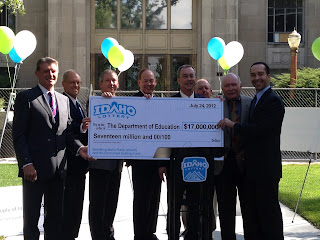Today the second Idaho Science and Aerospace Scholars of 2012 came to a close as students, parents, mentors and honored guests attended a VIP luncheon in a meeting room of Yanke Family Research Park. In order to prepare this morning for the luncheon, the students practiced their presentations and filled out surveys which would better the program for future years. The students were found themselves caught among different emotions as the day progressed: excitement to see family, anxiety to speak publicly, and a nagging disappointment to leave behind so many new friends so soon.
As observers of the students throughout the week, it was amazing to watch a group of high-schoolers from across an entire state gel so quickly and design an original mission to Mars, all while experiencing countless different STEM (Science, Technology, Engineering, and Mathematics) opportunities. What these students have achieved in the past week is astounding. Idaho is truly fortunate to be one of only five states to take part in the High School Aerospace Scholars program. The state is also exceptionally lucky to have such amazing students within its borders. With students like these earning these experiences, Idaho has a bright future indeed.
As observers of the students throughout the week, it was amazing to watch a group of high-schoolers from across an entire state gel so quickly and design an original mission to Mars, all while experiencing countless different STEM (Science, Technology, Engineering, and Mathematics) opportunities. What these students have achieved in the past week is astounding. Idaho is truly fortunate to be one of only five states to take part in the High School Aerospace Scholars program. The state is also exceptionally lucky to have such amazing students within its borders. With students like these earning these experiences, Idaho has a bright future indeed.
 |
| Students sharing their projects previous to the lunch with parents. |
Later in the day, the students left the BSU Micron Engineering Building one last time, wearing their respective team colors and chatting excitedly to one another. When the luncheon began, students mingled with parents and met the relatives of their new friends as well as special guests. The luncheon opened with an address by ISAS director Peter Kavouras and the reading of a letter from Governor Butch Otter addressed to the ISAS program.
After hearing what the governor wished to say to the students, all those in attendance ate delicious pasta and chicken with all sorts of sides. The ballroom filled with the sounds of clinking silverware, conversation, and music as a commemorative video of the 2012 Academy played on a screen in the background. Once the meal was completed, each team stepped up to the stage in order to present their respective components of the mission accompanied by a PowerPoint presentation. The parents listened carefully and in some amazement. Here in front of them were their high school children, the same children who were dropped off at Boise State University one week ago, presenting revolutionary ideas as professionals. To witness such an event, parents could not help but feel proud as their children displayed a striking maturity and air of success, uncommon in the typical high school student.
After hearing what the governor wished to say to the students, all those in attendance ate delicious pasta and chicken with all sorts of sides. The ballroom filled with the sounds of clinking silverware, conversation, and music as a commemorative video of the 2012 Academy played on a screen in the background. Once the meal was completed, each team stepped up to the stage in order to present their respective components of the mission accompanied by a PowerPoint presentation. The parents listened carefully and in some amazement. Here in front of them were their high school children, the same children who were dropped off at Boise State University one week ago, presenting revolutionary ideas as professionals. To witness such an event, parents could not help but feel proud as their children displayed a striking maturity and air of success, uncommon in the typical high school student.
The luncheon continued with addresses by Superintendent Tom Tuna and Dr. Tony Roark and Micron's Cory Morasch. All emphasized just how important this program has been to the students, and the positive impact it has had on all of their lives. Mr. Morasch's address left the students hollering a boisterous ‘hoorah’ as they answered his many impromptu questions concerning what the program has done for the students.
 |
| Superintendent Luna speaking to the students. |
The luncheon came to a close with the presentation of diplomas and prepared speeches by a few of the students who were adamant in sharing their experiences with all those present. Some even brought tears to his, and the audience's eyes.
 |
| The students received diplomas for their completion of the program. |
On behalf of the Department of Education and the entire State of Idaho, we would like to congratulate ISAS 2012 Academy, and which everyone an amazing summer. Good luck to all of the scholars this season and we know you will all be able to achieve the dreams you were able to dream this week!
-Jaime Guevera, Heidi Hughes-















